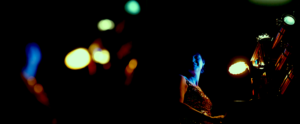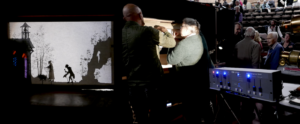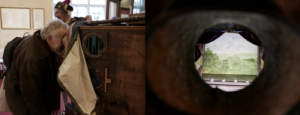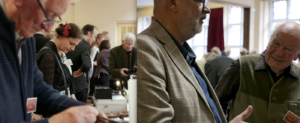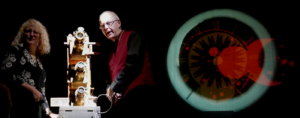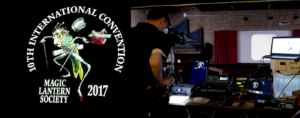Birmingham, England, 28–30 April 2017—A Magic Lantern Convention is first and foremost a projected affair. As an event organized around a variety of lantern-based presentations—from entertainments, to scholarly research, to combinations of the two—its arguments happen on the screen. To the traditional features of a main program, exhibition, collector’s market, and grand auction, this year’s Convention, held at the Birmingham and Midland institute, added many new attractions: a changing program of sideshows, a Magic Lantern Cabaret, and a performance of live projections and music at a local theatre. On the whole, the event made a case for the lantern’s extended repertoire—its use in the twentieth century, its expressive range, and its correspondence with cinema and other forms of popular culture.
At the outset, the lantern’s relation to music publishing and cinema was highlighted in Margaret Bergh’s “Picture the Songs—Rum-Ti-Tum and Fiddle-Dee-Dum: Notes from American Illustrated Songdom,” a presentation of ragtime hits from the 1910-1912 era. In the mid-1890s, Tin Pan Alley, the cluster of songwriters and music publishers associated with the block of New York City’s West 28th Street that dominated American popular music, began promoting its latest songs with photographic “live-model” slides illustrating their storylines. American song slides from the Marnan Collection, introduced by Margaret and Nancy Bergh at the first International Convention in 1983, shed significant light on early cinema exhibition and reception, and have been featured in important studies by Richard Abel, Rick Altman, and others. Performing a number of the then latest songs by Irving Berlin, Ted Snyder, and Joseph Stern with modern slides by Scott & Van Altena, A. L. Simpson, and De Witt C. Wheeler, Bergh’s presentation offered a rare chance to experience ragtime music and dance styles “pictured.” After the final number, a rousing rag called “Lovie Joe” that catapulted Fanny Brice to stardom in her debut season with the Ziegfeld Follies of 1910, it was easy to see how this particularly American attraction was a fixture of the nickelodeon screen.
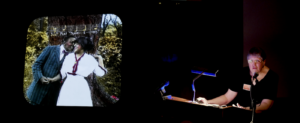
Margaret Bergh presents “Picture the Songs—Rum-ti-tum and Fiddle-dee-dum: Notes from American illustrated songdom” (photos by the author)
Another noteworthy presentation from the main program was When Grim Senji Grinned, a lantern filmstrip produced by the Japan Magic Lantern Culture Co. Ltd. in 1956. Presented by Yoriko Iwata and Hana Washitani, the filmstrip, rediscovered in 2007, was made for the Coal Miners’ Union, which played it at their meetings. Set in a Japanese colliery, it tells the story, in 48 frames, of a coal miner named Senji’s courageous resistance to the unreasonable demands of a tyrannical foreman. The filmstrip’s realistic puppets and sets, chiaroscuro lighting, and sophisticated black and white photography reflect the high professional standards of Japanese still-image projection practices during the post-WWII gentō revival, when lantern slides and filmstrips flourished as economical, grass-roots alternatives to films.
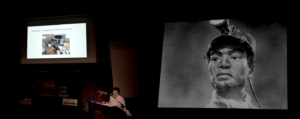
Yoriko Iwata (L) and Hana Washitani present the 1956 lantern filmstrip, When Grim Senji Grinned: A Story of Solidarity in a Japanese Colliery (photos by the author)
In a more humorous vein, Dick Balzer’s Cabaret performance, “Time to leave, a Cautionary Tale,” satirized Brexit and the Trump presidency with fairytale slides (“what small hands you have, Grandma…”). Gwen Sebus and Sarah Dellman’s witty lantern essay, “The Life and Inventions of Christiaan Huygens: a secret history of lantern slides,” examined a range of lantern slides containing hidden references to the Dutch polymath, exposing a centuries-long conspiracy of international lantern manufacturers to pay homage to “the founding father” of their trade. Incidentally, the creative re-use of lantern slides is one of the themes to be taken up later this summer at the A Million Pictures conference, Universiteit Utrecht.

“The Life and Inventions of Christiaan Huygens: A secret history of lantern slides” by Sarah Dellmann, Gwen Sebus, and Michael van de Leur (photos by the author)
In addition to the main program, a changing program of sideshows could be seen during breaks. Of special note were Boelmans Kranenburg and Annet Duller’s shadow theatre in miniature, Frog Morris and Nicole Mollett’s multimedia cabinet of curiosities, The Curious Chamber, and “Raree Man” Tony Lidington’s Peepshow.
The Convention’s special exhibition, curated by Lester Smith, was organized around the theme of Victorian Fun for Children. It offered an amazingly wide variety of domestic media—lantern slides, toy lanterns, cinematographs, postcard projectors (epidiascopes), flick books, filmstrip lanterns, and optical toys and ephemera from the 1860s to the 1990s. Objects of great interest could also be browsed, examined, and acquired in the market room.
Without a doubt, the most original and memorable event of the Convention was “Magic and the Muse,” an evening of live projections, contemporary music, and performance at the Crescent Theatre. The event grew out of a two-year collaboration among musicians Richard Navarro and Nicholas Thurston, and lanternist Jeremy Brooker, who combined with lanternists Carolyn Brooker and Mervyn Heard, and musician Miriam Gould. The ensemble created a spectacle of color, light, and sound that featured “living pose” slides previously used by the parents of actor Peter Sellers in the 1920s, and new images hand-painted onto glass.
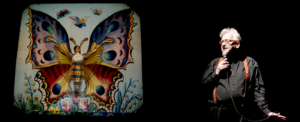
Miriam Gould transforms into a butterfly and Mervyn Heard sheds light on “living pose” slides in “Magic and the Muse” (photos by the author)
Given the wide range of technological demands, insuring that the Convention ran smoothly was, of course, no small thing. Kudos to the AV department for maintaining impressively high production values throughout the event.
The Magic Lantern Society, UK, held its first Convention in London in 1983. Now forty years old, the Society enjoys a robust membership of collectors, scholars, archival organizations, performers, and artists from thirty countries. Although the MLS UK Conventions only take place every four years, devotees of the lantern can catch the biennial Conventions of their sister organization, the Magic Lantern Society of the US and Canada, between the UK events.


